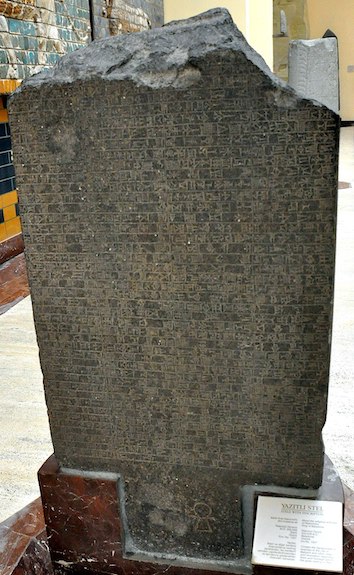Kagula (a gate of Esagil at Babylon)

This gate was an entrance of the "Main Courtyard" of Esagil, which could either be identified as the Court of Bēl (the central courtyard of the main part of the temple) or the Grand Court (the principal courtyard of the eastern annex building). Nabonidus, Babylon's last native king, claims to have provided it with new metal-plated cedar doors.
Names and Spellings
The Sumerian ceremonial name of this gate means "Large Gate."
- Written Forms: ka₂-gu-la.

The lower half of basalt stele (Ist EŞEM 01327) that is inscribed with a long Akkadian inscription of the Neo-Babylonian king Nabonidus. The so-called "Babylon Stele" records that ruler's work on Esagil, including providing the gate Kagula with new doors. Image reproduced via Creative Commons Attribution-Share Alike 4.0 (CC BY-SA 4.0) license via Wikiwand.
Known Builders
- Neo-Babylonian (ca. 625–539 BC)
- Nabonidus (r. 555–539 BC)
Building History
An Akkadian inscription of the Neo-Babylonian king Nabonidus written on a broken basalt stele records that he renovated and refurbished some of the principal gateways of Esagil, including the entrances of the "main courtyard," principally by providing them with new wooden doors. Egula was one of those entrances. The relevant passage of the so-called "Babylon Stele" reads:
Archaeological Remains
Egula has not yet been positively identified in the archaeological record. If this entrance was a gate of the Court of Bēl, then it might been one of the gates (labelled a–l) excavated in the main part of Esagil by the Deutsche Orient-Gesellschaft (DOG) and Königliche Museen Berlin (KMB) under the direction of Walter Andrae in 1900 and by Friedrich Wetzel and Klaus Müller in 1910–11. Note, however, that it is presumably not to be identified as Gate h because that entrance is identified as Kagal, the central western gate of the Court of Bēl, which provides access to Eumuša (the cella of the god Marduk). Should Egula be an entranceway of the Grand Court, then Egula might be tentatively identified with Gate H, the southern gate of the eastern annex building which was excavated by means of tunnels in 1910–11 and which abuts the southeast corner of the main building of Esagil.
Further Reading
- George, A.R. 1992. Babylonian Topographical Texts (Orientalia Lovaniensia Analecta 40), Leuven, pp. 395–396, 403 and 414–416.
- Wetzel, F. 1938. Das Hauptheiligtum des Marduk in Babylon, Esagila und Etemenanki (Wissenschaftliche Veröffentlichung der Deutschen Orient-Gesellschaft 59), Leipzig, 4–13 and pls. 3–5.
Banner image: areal photograph of the excavation pits and trenches in the area of the remains of Esagil and Etemenanki taken in 1923 (left); a reconstruction of Esagil and Etemenanki during the reign of the Neo-Babylonian king Nebuchadnezzar II (center); a plan of Esagil, and Etemenanki (right). Images from O. Pedersén, Babylon: The Great City, pp. 144–145 figs. 4.3–4.4 and p. 151 fig. 4.11.
Jamie Novotny
Jamie Novotny, 'Kagula (a gate of Esagil at Babylon)', Babylonian Temples and Monumental Architecture online (BTMAo), The BTMAo Project, a sub-project of MOCCI, [http://oracc.org/btmao/Babylon/TemplesandZiggurat/Esagil/RoomsandGates/Kagula/]